





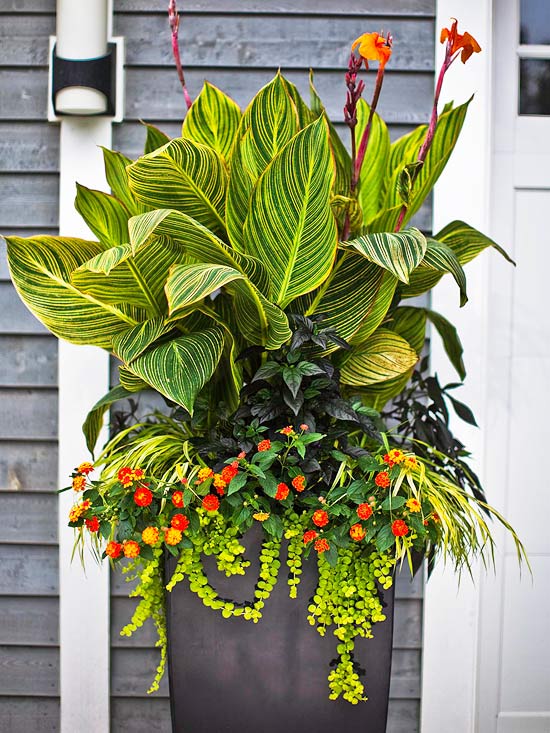
Today's modern cannas are the can-do, go-to, problems-few flowers that modern gardeners crave. From the cold winter gardens of the North to the hot spots of the South, low-maintenance cannas can do color in just about any climate.You might walk right past pastel plants that blend into the landscape, but cannas are the divas of garden design; they refuse to be ignored. New varieties sizzle with colorful leaves, dashing blooms, and compact habits.
Cannas grow from swollen roots known as rhizomes and are treated as an annual in cold-winter climates or as a perennial in frost-free locations. In mild-winter areas, cannas can be left outdoors in the ground all winter, as long as they are planted in a mound for good drainage and covered with a waterproof tarp and mulch to keep their roots warm and dry.
continue reading belowCannas have strong stems that rarely need staking and are resistant to many insects, but they do have some demands to keep them handsome and happy.
To keep the cannas coming, keep them tidy through the summer by pruning off spent flowers and by cutting the stalks to the ground in the fall. If you feel like growing cannas from scratch, they produce hard, black, bulletlike seeds that can be collected from the flowers in late summer.
1. Store seeds in labeled paper envelopes until early spring.
2. Seeds need to be notched with a file and soaked in warm water overnight before planting. Sow the seeds in open, uncovered flats or pots of soil.
3. Place pots where they get bottom heat, such as on top of a radiator, refrigerator, or heated greenhouse bench.
4. Transplant young plants outdoors after weather is warm in early summer.
5. Cannas today are mostly hybrids, so seeds will not breed true, but they might produce interesting new varieties. In warm climates, seeds may bloom the first year.
1. In the fall, once the cannas start to wither or the foliage is damaged by the first frost, dig up the underground rhizomes. Use a spade or garden fork, and pry the rhizomes up gently to avoid breaking them.
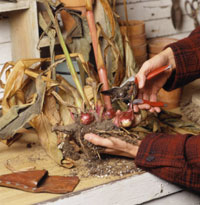 Step 2.
Step 2.
2. Cut the top growth from the rhizomes, leaving 1 to 2 inches of stem.
3. Brush off excess soil, but don't worry about getting every speck.
4. Purchase bulb-saving solution and prepare by following directions on the package label. This will sterilize the rhizomes to prevent fungal disease while bulbs are overwintered. This step is particularly important if the plants suffered from fungal disease during the summer.
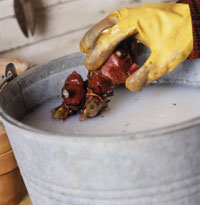 Step 5.
Step 5.
5. Dip or soak rhizomes in the solution according to package directions.
6. Place the rhizomes in an open tray in a well-ventilated area, and allow them to dry for several days.
7. Fill paper bags halfway with peat moss, vermiculite, or another dry, sterile medium. Place a few rhizomes in the bag, seal it, and shake the bag to distribute the peat moss. Using multiple small bags will help prevent the spread of fungal disease through the entire batch.
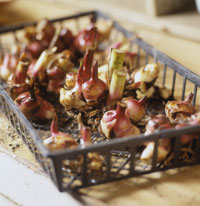 Step 6.
Step 6.
8. If you know the cultivar or the color of the canna, label the bag. You might want to add a planting date that is a few weeks after the last expected frost in your area. This will remind you to replant the rhizomes in late spring, after the soil has warmed. Mark the date on your calendar indoors as well. Store the bags in a cold but not freezing location, such as a garage, basement, or even under the crawl space of the house.
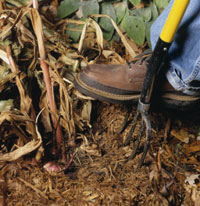
In mild winter climates, winter rains rot the tubers more often than cold kills them. If the soil rarely freezes down to the 5-inch level where you plant the rhizomes, you can use this no-dig method of canna storage.
1. Plant cannas at the top of a mound or in a raised bed for good drainage.
2. Cut back top growth all the way to the ground in the fall.
3. Cover the mound or bed with a tarp or heavy plastic to keep out rain and snow.
4. Mulch with a few inches of pine needles, bark, or straw to add insulation and keep the covering in place.
5. In late spring, remove mulch and tarp so cannas can emerge from dormancy.
Copyright © www.100flowers.win Botanic Garden All Rights Reserved